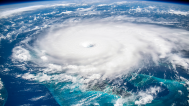气象科普:台风“千奇百怪”的名字是怎么来的?

How are typhoons or hurricanes (depending on geography) named? The practice of naming these storms has a long history. Before the 20th century, they were named by the time they appeared or the place where they landed. For example, the hurricane that destroyed Galveston in 1900, killing 6,000 — 12,000 people, is remembered as the Great Galveston Hurricane.
The practice of giving storms personal names appears to start from Clement Wragge. He was an Australian meteorologist (气象学家). In 1890s, he named storms after women, story characters, and politicians that he didn’t like. The modern system of using personal names developed during World War II. At that time, people began using women’s names. Short and quickly understood, names were easier to send by the radio and easier to keep straight if there was more than one storm in a given area. In 1953, the system was made formal. And men’s names were added to the list in 1979.
How are storm names picked today? A special group of the World Meteorological Organization maintains lists of names to be used for storms. The names on the list must be short, special, and have something to do with their cultural and geographic areas. For the Atlantic basin (海盆) there are six lists of 21 names each. If there are more than 21 named storms, Greek letters are used. For the Western Pacific/South China Sea basin, names on the lists are given by countries. The lists recur yearly. But if a hurricane or typhoon is especially destructive (破坏性的), that name will not repeat again, such as Katrina (2005), Sandy (2012), Haiyan (2013), Meranti (2016), Harvey (2017), Irma (2017), and Michael (2018).
原创编写 版权所有 侵权必究! 每日更新 个性化阅读 英语飙升!